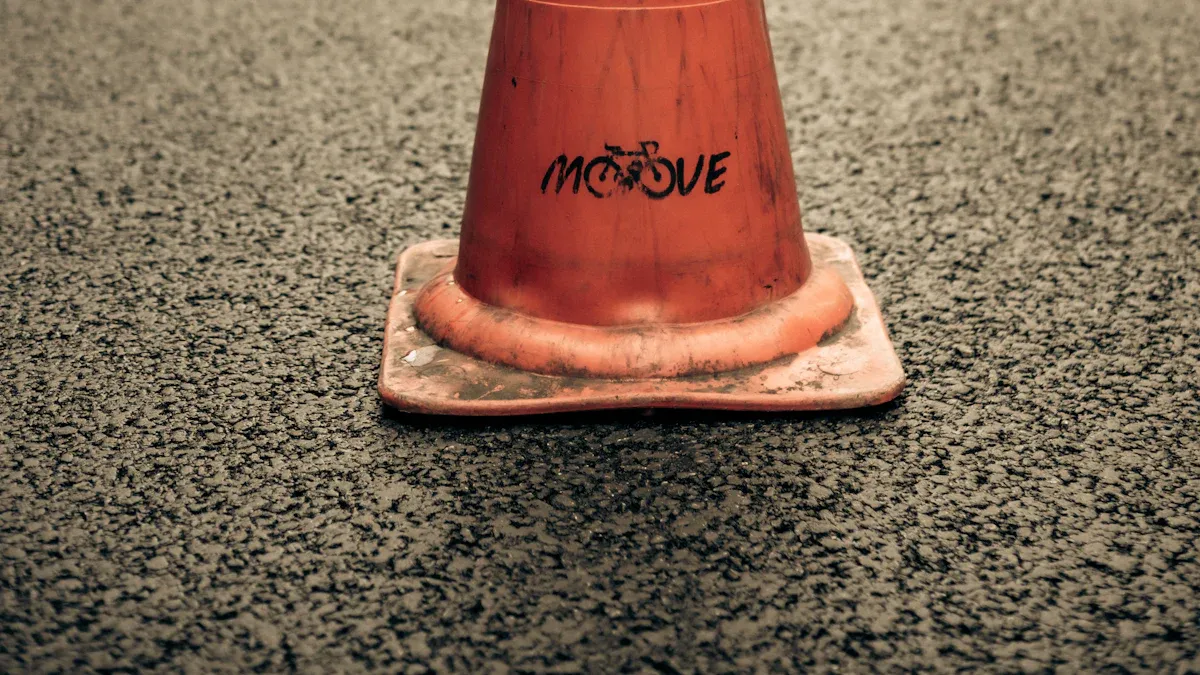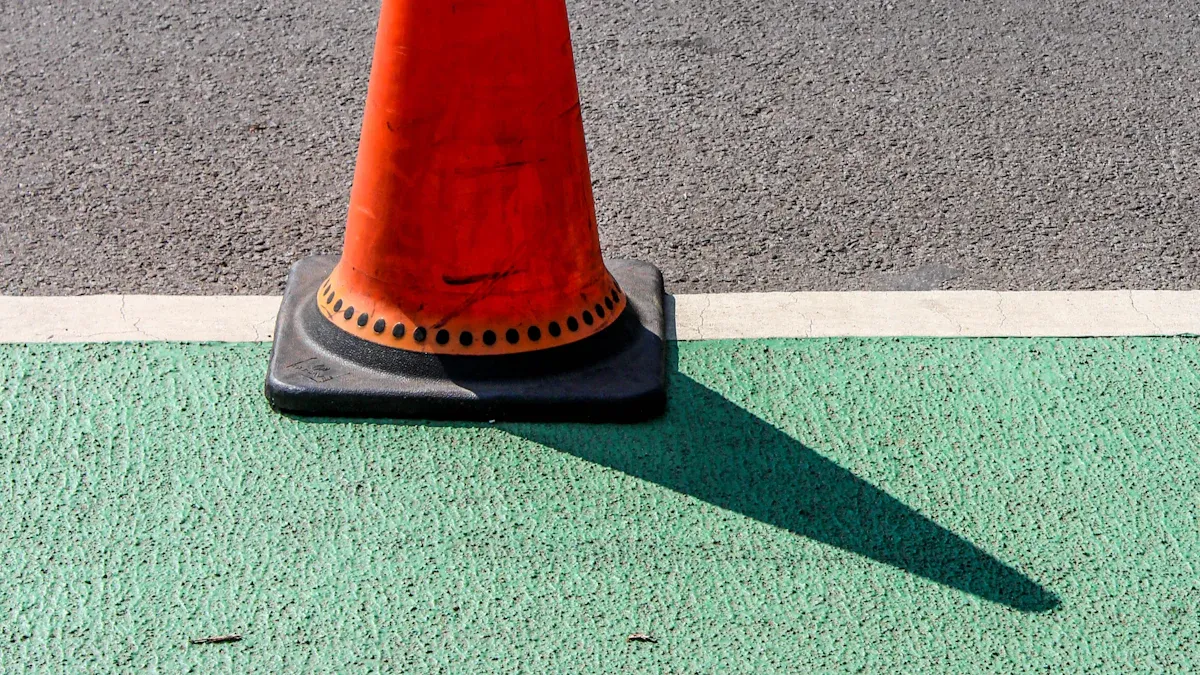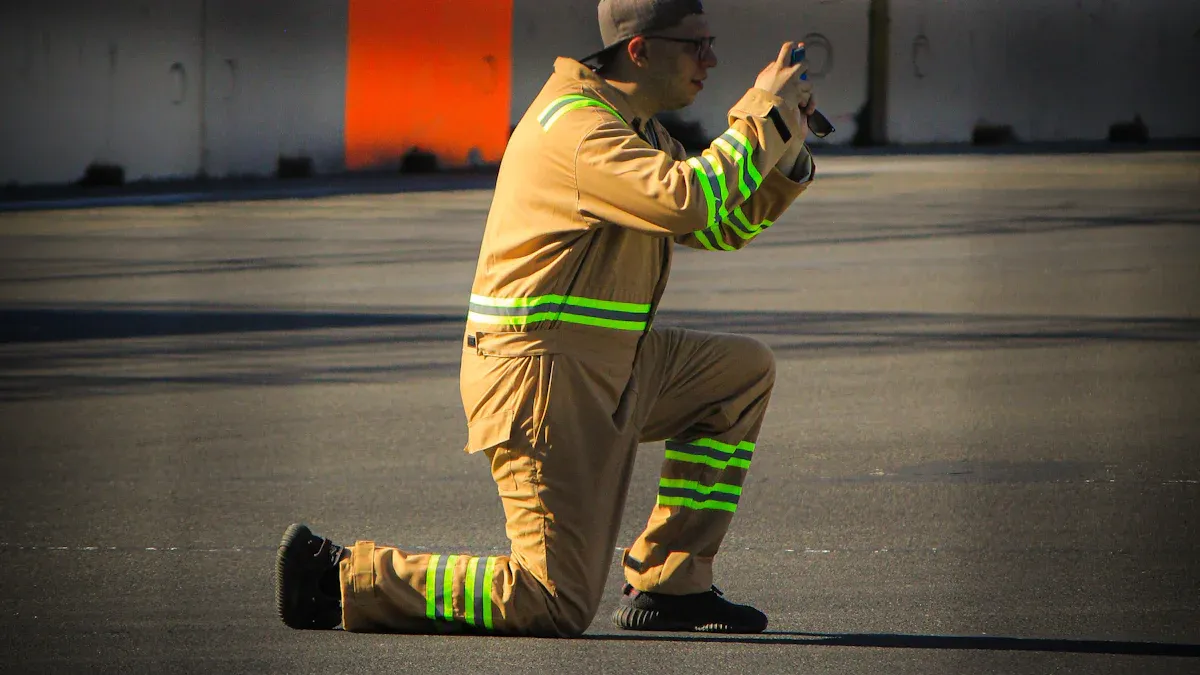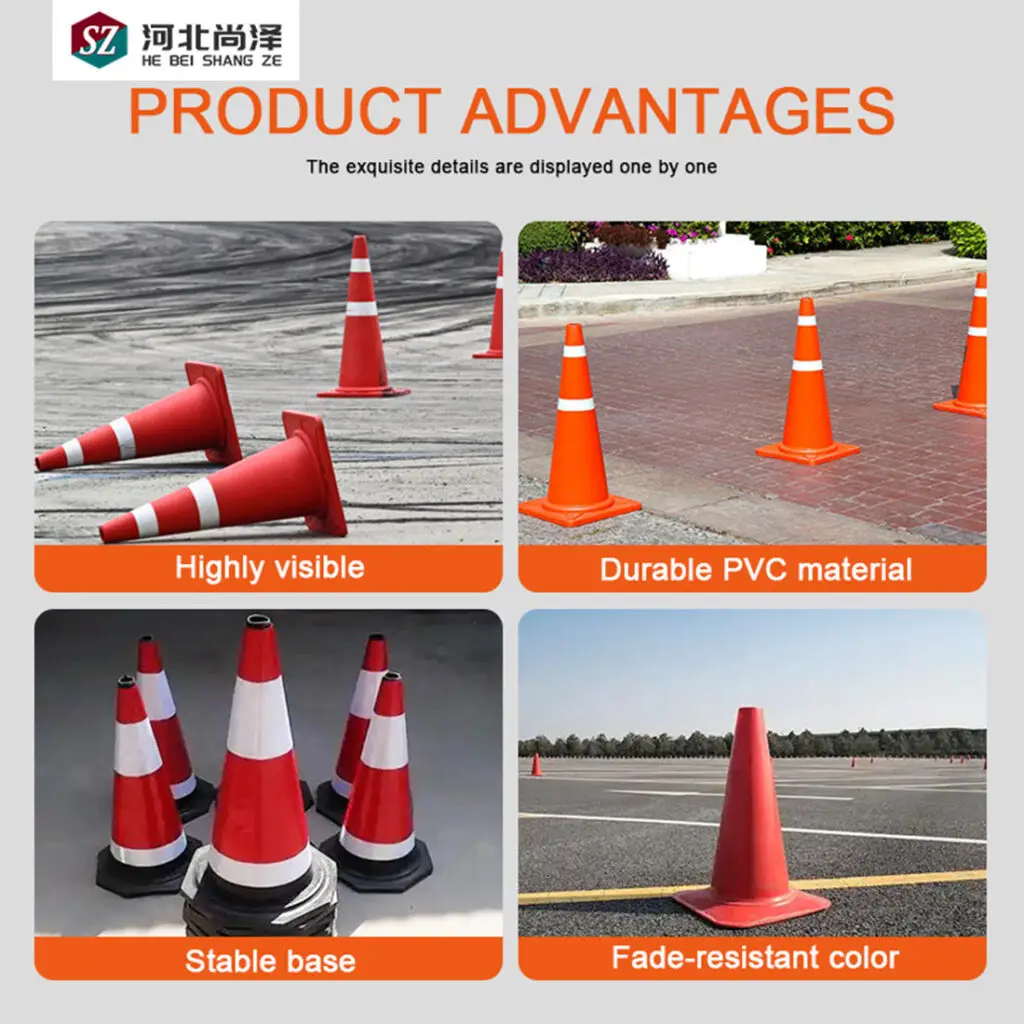
Traffic cones are important for road safety. They help you see dangers and pay attention when driving. When you spot these cones, you know to slow down. You also know to follow new driving paths. Studies show that different ways to set up cones can make cars go slower. For example:
| Cone Arrangement Type | Speed Reduction Effectiveness |
|---|---|
| Straight Line | Moderate |
| Converging Pattern | High |
| Parallel Rows | Greatest |
You help keep workers and other drivers safe by following these markers. Traffic cones now stand for safety and order on busy roads.
Key Takeaways
- Traffic cones help keep roads safe. They warn drivers about dangers. They show drivers where to go in work areas.
- Different ways to set up cones can slow cars down. Cones placed close together work best for this.
- Always look at traffic cones when you drive. They show when the road changes. They help stop crashes from happening.
- Traffic cones keep workers safe. They make safe spaces for workers. They guide cars away from risky spots.
- Collapsible traffic cones are good for emergencies. You can store them easily. You can set them up fast when needed.
Importance of Traffic Cones

Traffic cones are very important for keeping everyone safe on the road. You see them on highways and in neighborhoods. They do more than just mark a spot. They help stop accidents, show you where to go, and keep workers safe during roadwork or emergencies.
Preventing Accidents
You count on traffic cones to warn you about dangers ahead. These orange markers are easy to see from far away. They tell you to slow down and watch out. When you spot them, you know something is different on the road. Traffic cones split up lanes, guide you around work zones, and show where there are potholes or sharp turns. Their spots give you time to slow down or change direction. This helps stop crashes.
Tip: Always look for traffic cones when you drive somewhere new. They often mean the road has changed or there is a hidden danger.
Traffic safety cones use bright colors and shiny collars. This makes them easy to see day or night. Studies say that using cones in busy places lowers accident risk. They also help slow down cars and keep people alert.
Here is what transportation authorities say about why they use traffic cones:
| Reason for Use of Traffic Cones | Description |
|---|---|
| Enhancing Visibility | Traffic cones are easy to see and show drivers where to go. |
| Compliance with Safety Standards | Using cones the right way can save lives by making roads safer. |
| Instilling a Culture of Safety | Using cones shows that safety matters for workers, drivers, and walkers. |
| Triggering Behavioral Change | In emergencies, cones help move traffic and show what to do. |
Visual Cues for Drivers
Traffic cones are important because they give you clear signs. Their orange color and shape stand out. Shiny strips help you see them at night. When you see cones in a row, you know where to drive and where not to go.
- Traffic cones make clear lines that tell you to be careful.
- The bright color and shape help you notice them fast.
- Shiny strips make them easy to spot at night.
- They help control lanes and show detours in work zones.
- Cones guide you away from crashes and mark temporary traffic areas.
Traffic cones work better than many other signs. Their design helps you react faster and avoid accidents. You can trust them to keep you safe when roads change.
Protecting Workers
You help keep road workers safe when you respect traffic cones. These cones make space between workers and cars. They show where crews can work and keep you out of danger.
- Traffic cones and drums show where construction is happening.
- They guide cars into the right lanes and show detours.
- Good placement helps follow safety rules.
- Cones make safe spaces for road crews.
Numbers show that cones lower the chance of accidents, even at night. Flares might work better sometimes, but cones are still very important for worker safety. You see how useful they are in every roadwork area.
Note: Always slow down and follow the path marked by traffic cones. You help protect workers who keep roads safe for everyone.
Traffic cones are very important. They keep you, other drivers, and workers safe. They make roads safer by giving clear signs and making safe zones. You see them every day because they really work.
Standard Traffic Cone Features
Durable Materials
Standard traffic cones are made to last a long time. They use materials like polyvinyl chloride (PVC), polythene, or rubber. These materials help cones stay strong and bend easily. PVC cones bend but do not break. They go back to their shape after being hit. Polythene cones are tough and easy to stack. This makes them simple to store and move. Rubber cones are heavy and stay in place during strong winds. They do not get damaged by cars or bad weather.
Here is a quick look at the materials and their features:
| Material Type | Characteristics |
|---|---|
| Polyvinyl Chloride | Flexible, lightweight, weather and UV resistant, returns to original shape after impact. |
| Polythene | Strong, durable, suitable for rough handling, can be recycled, easy to store and transport. |
| Rubber | Highly weighted, stable, withstands wind, reduces accident risk, excellent weather resistance. |
Standard traffic cones work well in rain, sun, and snow. Reflective strips and special coatings help you see them in any weather.
High Visibility
Standard traffic cones are made to be easy to spot. Bright colors like orange, lime green, or neon yellow stand out. You can see them in daylight and at night. Reflective strips use glass beads to shine under headlights. This helps drivers see cones in rain or fog.
On fast roads, you see 36-inch standard traffic cones. These cones have big reflective bands. The Manual on Uniform Traffic Control Devices (MUTCD) sets rules for these bands. The top band is 6 inches wide. The lower band is 4 inches wide. Both bands use special shiny material. This design helps drivers notice cones quickly. It is important for safety and traffic control.
| Evidence Type | Description |
|---|---|
| Reflective Panels | Reflective panels make light bounce back, so roads stay marked even when it is dark. |
| Bright Colors | Bright colors like lime green work well in sunlight and at night, making cones easy to see. |
Universal Symbol of Safety
When you see a standard traffic cone, you know it means safety. People everywhere know cones mean slow down or follow directions. Studies show standard traffic cones can lower accidents by up to 30%. There are more than 140 million cones used around the world. They help keep roads safe and organized.
Standard traffic cones guide drivers and mark work zones. They protect workers by making a clear barrier. This simple tool helps everyone know where to go and what to avoid. It makes traffic control safer for all.
Tip: Always pay attention to a standard traffic cone. It stands for safety for you and everyone else on the road.
Traffic Cones in Emergencies

Quick Deployment
When there is an emergency on the road, you must act fast. Traffic cones help you make a safe area in just a few minutes. Emergency teams use cones that are at least 28 inches tall on highways. These cones have reflective material so drivers see them at night. You should put cones out to guide cars and mark the emergency zone. Emergency vehicles usually carry at least 16 cones for this job. Reflective cones help everyone see the area, even when it is dark. You should check cones often to make sure they are not damaged or faded. Park emergency vehicles to make a buffer between moving cars and workers.
Tip: Collapsible cones are easy to store in emergency vehicles. You can keep them in small spaces and set them up fast when you need them.
Emergency teams use cones to close lanes and control traffic around accident scenes. You can make a taper with cones to move traffic away from danger. The number and spot for cones depend on the road’s speed and lane size. At night, you can use flares with cones to help drivers see better.
Managing Hazards
You can use traffic cones to handle many types of hazards. Their light weight makes them easy to move and set up. You can quickly make safety zones and guide cars away from danger. Cones work well for:
- Temporary hazards from road work
- Equipment problems or breakdowns
- Weather issues like flooding or fallen branches
- Sudden changes in work zones
You can also use cones to mark utility work, guide cars away from holes, and protect emergency workers at accident scenes. Cones tell drivers and walkers to stay alert and avoid the marked area. This helps lower the risk of injury for everyone.
Traffic cones are a big part of traffic control equipment. You see them in construction zones, parking lots, and at public events. Their bright color and shape make them great for temporary traffic control. When you use cones the right way, you help keep roads safe and organized for everyone.
Driver and Pedestrian Safety
Safe Zones
You use traffic cones to make safe zones on busy roads. These cones show where work is happening. They keep you away from dangerous spots. When you see cones, you know where it is safe to walk or drive. You help keep workers and other drivers safe by following these markers.
- Traffic cones show where construction or maintenance is happening.
- They guide you and protect workers and drivers.
- They warn you about changes like lane closures or detours.
- By guiding traffic, they help stop accidents and lower crash risks.
You notice cones are bright and have shiny bands. This makes them easy to see at night or in bad weather. When you respect these zones, you help keep everyone safer.
Tip: Always stay inside the marked path when you see cones. This helps keep you and others safe.
Clear Detours
Traffic cones help you follow detours easily. When a road closes or changes, cones guide you around. You see clear lines that show where to go. This stops confusion and keeps traffic moving well.
- Traffic cones make detours easy for drivers and walkers.
- They help you see better in risky places and make routes clear.
- Cones guide you around road work and utility jobs.
- They warn you about dangers that are hard to spot.
| Source | Description |
|---|---|
| A Comprehensive Guide to the 7 Different Types of Traffic Cones | Traffic cones mark work zones, lane closures, or accident sites. They help you see better and lower accident risks. |
| Collapsible Traffic Cones: Features, Benefits and Applications | Collapsible cones guide traffic and mark work zones. They help keep everyone safe during construction. |
| 5 Types of Traffic Control Equipment and Their Uses | Traffic cones move traffic and mark danger spots. They help drivers see better. |
You see that cones are important for temporary traffic control. They split car lanes from walking paths. They help you follow detours with confidence. By following cones, you help keep roads safe for everyone.
You help keep roads safe every day. When you see cones, you know where to drive. You also know how to stay away from danger. Experts say to use tall cones with strong bases in busy places. They also say to add shiny strips so you can see them at night. Community events teach people why cones are important. Fun campaigns help everyone learn about road safety. Support your town’s work to make roads safer. Always follow the zones marked to protect you.
FAQ
What makes traffic cones so important for road safety?
You see traffic cones on roads because they warn you about hazards. They guide you around work zones and help prevent accidents. Their bright color and shape make them easy to spot. You can trust them to keep you and others safe.
How do collapsible traffic cone and looper tube traffic cones differ?
You use a collapsible traffic cone when you need to save space. It folds flat for easy storage. Looper tube traffic cones have a tall, open design. You can connect them with ropes or chains to block off larger areas.
Where can you buy orange cones?
You can buy orange cones at hardware stores, safety supply retailers, or online marketplaces. Many stores offer different sizes and types. You can also find collapsible traffic cone and looper tube traffic cones online for special uses.
When should you use looper tube traffic cones?
You use looper tube traffic cones when you need to create a barrier for crowds or cars. They work well at events, parking lots, and construction sites. You can link them together to mark off large spaces.
Why choose a collapsible traffic cone for emergencies?
You choose a collapsible traffic cone because it fits in your car or emergency kit. It pops up quickly when you need to mark a hazard. This type helps you stay safe during breakdowns or accidents.






